I last participated in the John Moyle Memorial Field Day in 2010. Then I operated from the car park at Mt Donna Buang with a generator and a multi-band vertical. This year my interest in SOTA suggested that a combined Mt St Phillack and JMMFD SOTA activation would be a good idea. Scouting the available hilltops that were 10 point SOTA summits and had a good view of Melbourne for VHF/UHF purposes narrowed the choice considerably. Mt St Phillack fit the bill well apart from the length of hike to get to it (5km). I decided to give it a shot and set about working out what I could squeeze into a backpack to give myself the best shot at a decent score in the contest.
I decided to take my IC-7000 so that I could crank up the power if I needed and to provide coverage of HF and 6/2/70cm. This of course necessitated a hefty load of batteries given the approx 1.6A receive current drain of that rig! Next challenge was antennas for those bands. I went with a multi-band EFHW (as per a Dutch amateur – John PD7MAA – Multiband end fed antennas 3.5 – 30MHz) which covered 80/40/20/15m attached to a 10m squid pole. For 6m I constructed a Slim JIM from ladder line and also constructed a similar Slim JIM for 2m/70cm (inspired by Andrew – VK1NAM: 2m Slim Jim Antenna for SOTA). Finally I built myself a 8 element CheapYagi for 70cm.
The 6m Slim JIM was attached to the 10m squid pole whilst the 2m Slim JIM and 70cm yagi were attached to a 7m squid pole separated into 2 half poles (the thicker sections for the yagi and the thinner sections for the Slim JIM).
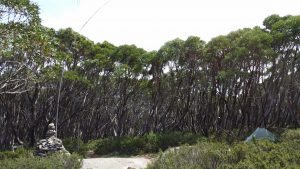
10m squid pole with 6m Slim JIM and EFHW antenna. Squid pole was attached to cairn a the end of the EFHW attached to the other squid pole visible on the tent and holding up the yagi. EFHW was in an inverted Vee configuration with the matchbox near the tent. The Squid pole was bending significantly with the wind and so I attached the EFHW several sections down from the top.
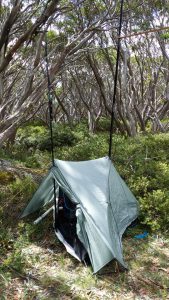
The Notch has ventilation flaps adjacent to the two support poles. These allowed the squid pole sections to be inserted and tied to the tent poles with velcro tapes.
Both the 7m squid pole sections were held up by the poles of my Tarptent Notch which conveniently has ventilation flaps adjacent to the poles (the Tarptent Notch uses hiking poles to hold it up).
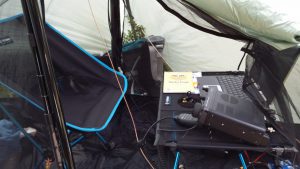
The Chair One from Helinox together with the matching table fit nicely inside the Notch and make a good operating position (albeit a little bit cramped!)
I’ve invested in an ultralight chair and table (from Helinox) which just fit inside the tent to form a tolerably comfortable operating position out of the weather. These are an amazingly compact and light chair and table that I think will be going with me on other SOTA outings!
Batteries for the operation consisted of 3 x 2.1Ah LiPos for the logging laptop and 4 x 5Ah LiPos for the IC-7000. I also took a dual band HT which didn’t end up getting used. Turned out I needed more battery for the laptop and less for the IC-7000 and so ended up using one of the 5Ah batteries for the laptop and got by with 3 x 5Ah batteries for the IC-7000. That’s for about 5:30 operating time with the IC-7000 probably averaging about 70W on Tx.
The hiking was interesting too. I parked at Mt St Gwinear carpark about 8:20am and took about 1:25 to hike up to the top of the summit with a 28kg pack on my back. I’ve decided 5km and 28kg is my limit! The weather was fine and sunny on the way up with a moderate wind. The wind had been forecast to be very strong at 30-35kt, however the reality was far less than that thanks mostly to the forest surrounding this summit.
Setting up all the gear took about 2.5 hours which was longer than I expected, so a good thing I left home early. I was ready to operate by just after 1:00 and got busy with contacts. The contest itself felt less busy than previous times I’ve entered. There were relatively few VHF stations around and propagation on HF was only average with very few stations worked from either VK4 or VK5. I found almost all of the HF activity on 40m and that was the only band I made contacts on. I heard quite a few DX stations on 20m, but chose to focus on VK stations for the contest. There was a lot of static crashes from the storms crossing Victoria all afternoon and this made it hard to work the weaker stations.
All the activity on the bands with the contest made it quite hard to get SOTA contacts. I called “CQ SOTA and Field Day” many times during the afternoon and it wasn’t until late afternoon that Peter (VK3PF) found me and spotted me (there was no mobile data coverage at the summit, only occasional voice/SMS – Telstra network). After that, I had half a dozen chasers. I managed two S2S contacts during the contest with Wayne (VK3WAM) on Mt Torbreck and Andrew (VK1DA) on Mt Ginini.
I was quite lucky with the weather compared to many other stations. It got steadily darker during the afternoon and by about 6:00pm I could hear thunder in the distance, but had only a small amount of light rain. About 6:45 there was a relatively close lightning flash (maybe a few km away) and I got a shock off the EFHW coax connector which was thankfully not plugged into the rig at the time. That was a salutary reminder that operating radios anywhere near thunderstorms is a BAD idea and promptly unplugged all the antennas. Turns out the timing was good as I managed to complete the tear down and pack up before the rain really started.
I left the summit about 8:00pm just as it got fully dark to re-trace my steps to the car. As I began the hike, the rain started in earnest and didn’t stop until after I got back to the Princes highway. The return hike was an interesting experience with the bush being lit up regularly by lightning flashes in the rain. I was well prepared for rain with a waterproof jacket, pants, gaiters and hiking boots, so whilst I was damp by the time I got to the car, I was not soaked. I’m very glad I took hiking poles as descending a track with lots of rocks and roots in the dark and wet with a heavy pack would be quite hazardous without them.
I was also glad that the St Phillack to St Gwinear carpark track is very well marked with ski poles and track markers – anything less would have been challenging in the conditions that night.
After a brief coffee and food re-charge at the carpark, I left for home and finally arrived at midnight, 18 hours after I left. It was certainly my most challenging activation so far, but quite satisfying. The contest outcome was modest with a total of 59 contacts and 309 points (which placed me 2nd in the single-op/phone/portable/all-band/6 hour section), but an enjoyable day anyway.
Here’s a few more photos of the setup:
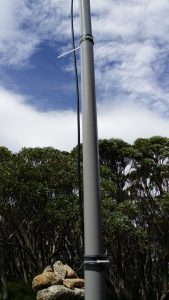
I reinforced the lower section joints with some bicycle tube rubber and cable ties to prevent collapse given the strength of the wind – seemed to work – no collapses in 5:30

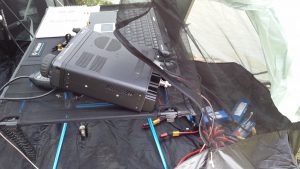
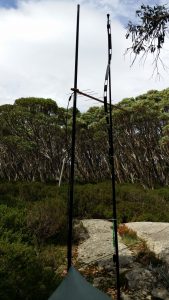
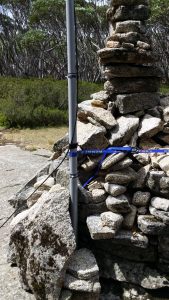
Hi David,
Nice to speak to you during the JMFD. It was wild, wet & windy over here, but I still had a lot of fun, hiding inside my little tent on the top of Mount Barker.
Thanks for a good read. I have added a link on my WordPress site to your site.
Best 73,
Paul,
VK5PAS.
Thank Paul. That seems to be a common story from the JMFD! Suspect the scores will be down a bit this year.
Hello David
A most impressive activation and a lot of weight to carry. Well done and you deserve every point!
John D
Thanks John. Yes, my legs have finally recovered!
Hi David interested to know how the SlimJim antennas performed, noting they are in the vertical plane?
Great write up and excellent pictures to give us some sense of the environment and challenges you dealt with.
73
Andrew, VK1NAM
Thanks Andrew. The Slim JIM antennas seemed to work well. I actually found that there was not much difference between the 2m Slim JIM on 70cm and the yagi. However this may have been due to the proximity of the other stations and the power they were using. Didn’t have time during the contest to do much experimenting though! I only made a few contacts on 6m, but that was mainly due to lack of stations. Certainly seemed to work OK. Theoretically there should be a significant difference, but perhaps in practice, multi-path reflections etc make the impact of the differing polarization less than you would think.